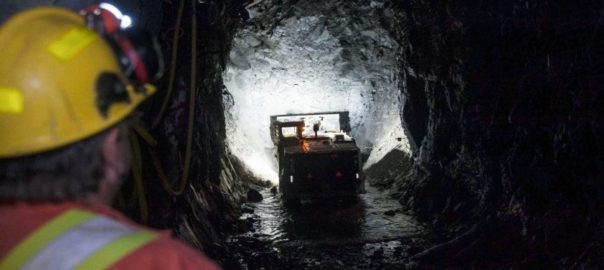An autonomous and teleremote solution from Epiroc has allowed Barrick Gold’s team at Hemlo in Ontario, Canada, to enhance safety, and reduce ventilation and climate control requirements, even as the underground mine goes deeper.
These innovations are the most recent addition to an automation programme at Barrick’s Hemlo open stope mine. The programme began with an autonomous truck circuit in 2007 and is now accelerating with a five-year plan following a year-long search for a solution offering the lowest cost, quickest implementation and solid product support, according to Epiroc.
Hemlo has produced more than 21 Moz of gold, and has been operating continuously for more than 30 years. It produced 196,000 oz last year and is expected to produce 200,000-220,000 oz this year.
The complex is made up of an open pit and underground mine, with the latter expected to operate until 2021 at an average production rate of approximately 3,600 t/d, according to the latest mine technical report.
Patrick Marshall, Manager Automation Projects for Barrick, said the company studied all available technology before settling on Epiroc’s solution.
“We had conferences with manufacturers and visited their facilities. We toured operations where their equipment was at work,” he said.
“We believe the Epiroc package featured the product support we wanted, had the best integration capability for our multivendor operation, had the right pricing model and, in general, was the best fit for our needs.”
Barrick preferred to use Cisco for wireless infrastructure, with Marshall explaining the Epiroc system was “easily adaptable for use with third-party wireless systems”.
For Hemlo, which is now being mined from around 1.4 km below surface, safety is the greatest benefit of the automation-ready Epiroc Scooptram ST14. Combining autonomous tramming with teleremote operation also increases productivity, according to Epiroc.
Hemlo Mine Superintendent Jon Laird said: “Automation and teleremote control get workers away from the operating environment to an office on the surface ‒ the ultimate in safe operation. And, since it continuously mucks from stopes at a steady rate even through shift changes, it eliminates having to move operators to it every shift.”
Laird said the 14 t-capacity Epiroc Scooptram is “so efficient it threatens to outpace crushing operations at the ore pass”.
One solution to this ‘overproduction’ being discussed is creating additional ore passes to give one crushing operation time to clear ore between dumps. The Scooptram loader can easily learn multiple routes and alternate between them.
“Other systems Hemlo looked at took up to a full shift for the route-learning process,” Epiroc said.
The automation zone is marked with a laseractuated barrier at Hemlo. Crossing this light curtain will trip a shutdown of the level and alarm those on surface. An electronic ‘key’ from a safety box near the light curtain is required before a unit can enter the zone.
Operator Wayne Locht said: “It (the key) connects the rig to the automation area so that the safety system knows that the rig is in the area.”
Equipment at Hemlo is tagged to display its location in the mine with Mobilaris real-time tracking software. The same Mobilaris technology is planned for miners’ hard hats by the end of 2018.
Once in the zone, Locht radios the operator waiting at the control room operator station on the surface, 1.4 km above the mine. The rig can now be operated from this vantage point.
Certiq, the telematics system installed on the Scooptram, will be important for tracking, documenting and analysing operational data to learn how much Barrick gains from its investment in automation, according to Epiroc.
Mucking is not yet an automated feature, so this task is carried out by Locht remotely once back on surface.
“Until the rig is refueled, after approximately 16 hours, no human being will visit the rig or enter the automation zone. Teleremote operators will monitor its routine, taking control only during loading and dumping operations,” Epiroc said.
Barrick’s next step is finishing the wireless infrastructure throughout the Hemlo mine, expanding the automation zones, and getting more loaders. A single operator will run more than one machine from a control station, and the mine will have more than one station. Operators at any station will be able to control any of the automated Scooptram loaders, anywhere in the mine.
Marshall said: “Today, we’re connected. Tomorrow we’ll have optimised fleet management. In the near future, we’ll achieve our ultimate goal – fully autonomous mining underground executed by our operators from the surface.”
Epiroc names five keys to success of this operation:
- “Mobilaris real-time location tracking: Mine-wide use of Mobilaris Mining Intelligence not only gives Hemlo real-time equipment tracking, but the precise location of each person underground – a vital advantage in case of an emergency;
- “Designed with operators in mind: Operators report high satisfaction with the ergonomics, power, comfort and features of the Scooptram ST14 loader. Transitioning to teleremote and autonomous operation is quick and easy to learn;
- “Capacity and speed boost productivity: The Scooptram ST14 loader with 14 t bucket capacity gives fast, fully loaded tramming speeds rated up to 29.5 km/h on level ground and up to 4.8 km/h up a 25% grade;
- “Safer, more comfortable environment: Automated LHD operation reduces ventilation and climate control requirements for deep mining operations and moves operators to a safer, more comfortable environment than is possible with line-of-sight radio remote control;
- “Multi-use Wi-Fi: Wireless infrastructure for autonomous operation also enables live access to performance data and provides minewide network access for location tracking and communication capabilities like mid-interval reporting.”







